Tyler F.M. Edwards's Blog, page 56
February 8, 2016
Review: Elysium
I enjoyed District 9 back in the day, so when I heard the director was putting out another sci-fi movie, titled Elysium, I was immediately interested. Of course, my life was a mess at the time, so it’s taken me until now to actually watch it.
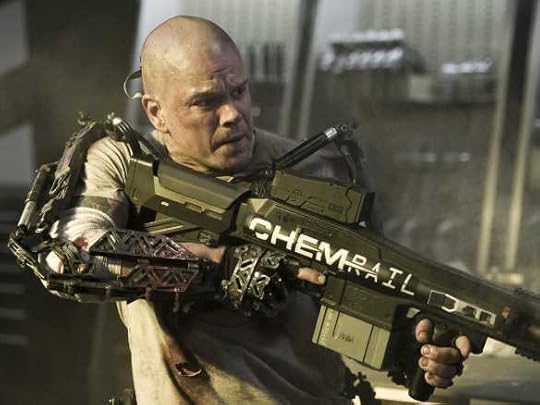 Set 150 years in the future, Elysium depicts a dystopic planet Earth utterly ruined by disease, overpopulation, and pollution. The wealthy have escaped to a vast, paradisaical space station, Elyisum, where their every need is fulfilled, and any sickness can be instantly cured.
Set 150 years in the future, Elysium depicts a dystopic planet Earth utterly ruined by disease, overpopulation, and pollution. The wealthy have escaped to a vast, paradisaical space station, Elyisum, where their every need is fulfilled, and any sickness can be instantly cured.
The story follows Max Da Costa, played by Matt Damon, an ex-con factory worker. He receives a lethal dose of radiation in an industrial accident and is given five days to live. Meanwhile, his childhood friend, Frey, struggles to support her daughter, who is dying from leukemia.
I think you can see where this is going.
I was expecting Elysium to be an intellectual, thought-provoking piece of science fiction. As it turns out, not so much. The story is fairly straightforward, and the messaging is quite ham-fisted.
In particular, the ruling class of Elysium are so cartoonishly heartless and evil it’s difficult to take seriously sometimes. Even my anti-corporate, pro-equality, angry leftist self found this to be a case of laying it on a bit thick. It’s certainly not the chillingly believable dystopia of Continuum.
Thankfully, though, Elysium does have other strengths to call upon.
 Elysium didn’t turn out to be a think-piece so much as a fairly standard sci-fi action adventure, but in that, it does its job well. The action sequences are brutal, visceral, and exciting. The special effects are spectacular, and the art design is strong. It manages to both an incredibly ugly movie and an absolute feast for the eyes at the same time.
Elysium didn’t turn out to be a think-piece so much as a fairly standard sci-fi action adventure, but in that, it does its job well. The action sequences are brutal, visceral, and exciting. The special effects are spectacular, and the art design is strong. It manages to both an incredibly ugly movie and an absolute feast for the eyes at the same time.
The main characters are a little thin, but they’re good enough to keep you engaged. Similarly, the acting is adequate but not award-worthy. I was able to forget I was watching Matt Damon after a while, at least.
Actually, the best acting probably comes from the main antagonist, played by Sharlto Copley, who is so skin-crawlingly vile from beginning to end that I spent half the movie visualizing gruesome and painful fates for him.
Elysium has a pretty strong emotional punch, and while the journey to get there is a little inconsistent, its ending is one of the more powerful and satisfying that I’ve seen in recent memory.
So in the end Elysium is a lot like District 9. It, too, was a bit rough around the edges, but ultimately it was a good movie, and the same is true of Elysium. Not a masterpiece, but worth your time.
Overall rating: 7.3/10
Filed under: Reviews Tagged: Elysium, movies, review, sci-fi








February 5, 2016
Gaming Round-Up: Li-Ming Impressions, Grey Goo’s Shroud, TSW, D3, and a Moose
It’s that time again: I’ve got a bunch of gaming topics that I want to discuss, but which aren’t quite meaty enough to fill an entire post.
 Let us not waste time.
Let us not waste time.
She’s so good she astounds herself:
At last, the final playable character from Diablo III has reached Heroes of the Storm. I might complain about them taking so long to add my favourite, but clearly they were just saving the best for last.
There weren’t many characters left I was super excited to see in Heroes, but Li-Ming is one of them, and on the whole, I’m fairly happy with how she turned out. I’m not sure she’ll threaten Jaina’s position as my go-to assassin, but she’s definitely a fun character.
The interesting thing about Li-Ming is that she feels very different from the game’s other heroes without resorting to coo-coo bananas weirdness like Abathur or Murky. Not that I don’t enjoy coo-coo bananas weirdness, but it’s good to know Blizzard can make heroes feel distinct in more subtle ways, as well.
Li-Ming is one of those hyper-specialized heroes. Her ability damage is absolutely ruinous, but her auto-attacks, much like the goggles, do nothing, and her health is so low that she instantly evaporates under any kind of pressure.
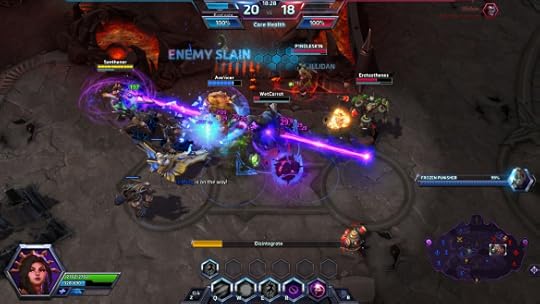 Based on that, I’m finding the best strategy is actually to not auto-attack at all and simply hang way at the back and bombard the enemy team with spells. Her spell range is very long (she even out-ranges towers, which makes for some intriguing possibilities), so it works surprisingly well, and it keeps her well out of harm’s way.
Based on that, I’m finding the best strategy is actually to not auto-attack at all and simply hang way at the back and bombard the enemy team with spells. Her spell range is very long (she even out-ranges towers, which makes for some intriguing possibilities), so it works surprisingly well, and it keeps her well out of harm’s way.
Zeratul is the bane of her existence, though. Why are all the characters I play hard countered by Zeratul? What did I ever do to him?
She looks amazing, too. The detail on her clothing and the expressiveness of her face are unbelievable. Makes me sad she looks so much crummier in her own game.
My only complaint with Li-Ming is that she’s another character who rides her mounts side-saddle. It was bad enough on Jaina, but it could not be more hilariously out of character for Li-Ming. Because we all know how shy, demure, and proper she is.
*Eye-roll.*
At least I’ve got my hoverboard from the Legacy of the Void CE.
 Random fun fact: I had a bit of trouble early on because I kept trying to teleport using the Diablo hotkey for it.
Random fun fact: I had a bit of trouble early on because I kept trying to teleport using the Diablo hotkey for it.
Grey Goo: Descent of the Shroud
Much to my surprise, sci-fi RTS Grey Goo launched a free DLC a few days ago that adds an entire new playable race. To the Beta, they are the Silent Ones. To the Goo, they are the Shroud. To all sentient life, they are the enemy.
Unfortunately, the new story content in Descent of the Shroud is limited to a single, very brief mission. At that point, you have to wonder why they even bothered. There aren’t even any new cinematics, which is a real shame because after all the hype I was eager to witness the Silent Ones in all their terrible glory.
The only conclusion I can come to is that the developers wanted to do more but simply didn’t have the resources. Again, it’s a real shame.
 I did play a skirmish map just to see what the Shroud are all about, and they turn out to be pretty interesting. They’ve got much of the creative design found in the Goo, but without being so awkward or irritating to play.
I did play a skirmish map just to see what the Shroud are all about, and they turn out to be pretty interesting. They’ve got much of the creative design found in the Goo, but without being so awkward or irritating to play.
Some of their units are very clever. For instance, their artillery, rather than firing a traditional projectile, summons an invulnerable unit that will run through the target area, damaging all it touches, until the artillery dies or is told to move.
As increasingly unlikely as it seems, I really do want to see a sequel or ambitious expansion to Grey Goo. It’s a game with some rough edges, to be sure, but some of the ideas behind it are really good, and the story represents some of the best science fiction I’ve seen in a video game.
And I definitely want to learn more about the Shroud. Where do they come from? What is their motivation? They’re such a mystery. I find it interesting that their entire mythos is about silence, but all their unit names are sound-related. Echo, klaxon, banshee, howler…
 The Secret World: Shambala
The Secret World: Shambala
I remain very happy with TSW’s new group finder. Queue times are very quick, and I’ve yet to have a bad run. Recently I got to run the Facility for the first time in forever, and I was reminded how much I truly love that place. It’s the sort of strange and fascinating story you can only find in The Secret World — mad Soviet scientists tear into reality deep beneath the earth to understand the deepest mysteries of the universe.
But the dungeon finder isn’t the only new addition of note. The game has also gotten its first new PvP mini-game post-launch, Shambala.
Having recently changed my view on PvP in TSW from “wouldn’t touch it with a thirty-nine and a half foot pole” to “it’s a decent diversion now and then,” I made sure to give Shambala a shot.
It’s definitely not like any other MMO PvP I’ve experienced. Shambala is single elimination death match. That is, if you die, you’re dead. No respawns, no second chances. Last team standing wins.
Making things even more frenetic are constantly spawning buffs and environmental hazards, and the arena regularly shrinks as a deadly winter storm closes in. Win or lose, it’s always over fast.
 All the matches I’ve played have been terribly one-sided, but they’re over so fast it’s hard to get frustrated. Even if you get your ass kicked, it’s not like you’ve wasted much time. It’s certainly a change of pace from the more drawn-out capture mechanics MMO PvP tends to focus on.
All the matches I’ve played have been terribly one-sided, but they’re over so fast it’s hard to get frustrated. Even if you get your ass kicked, it’s not like you’ve wasted much time. It’s certainly a change of pace from the more drawn-out capture mechanics MMO PvP tends to focus on.
D3: New zones
Diablo III has also had some more free updates recently. Patch 2.4 added several new areas, the most significant of which is Greyhollow Island.
It’s an interesting zone. It’s not really clear what’s gone on there, but clearly there is something terribly wrong with that island. Normally I find this kind of ambiguity in story-telling obnoxious, but when it comes to horror, I’m okay with it. The unknown is always scarier than the known.
It’s an incredible looking zone, too. I’ve often ragged on D3’s graphics, but Blizzard is getting better at making the best of a bad situation. The detail in the textures is outstanding. It also has lovely audio and some pretty interesting monster designs.
The new Eternal Woods area of the Ruins of Sescheron is also gorgeous, though it seemed a bit light on content when I went there. On the plus side, I ran into a new (to me) event in the older section of the ruins while I was there and finally met Abd al-Hazir.
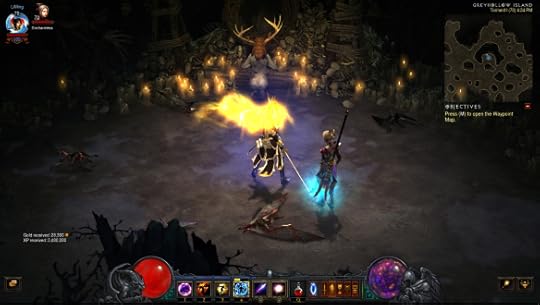 That was neat, but after so long, I would have liked to have his appearance be a part of some larger story, rather than some throwaway event in the middle of nowhere.
That was neat, but after so long, I would have liked to have his appearance be a part of some larger story, rather than some throwaway event in the middle of nowhere.
I did like how he followed me around and provided occasional commentary on my surroundings even after the event, though.
As nice as these updates are, and as much as I do respect Blizzard for offering new free content entirely out of the kindness of their hearts, I still remain impatient for an expansion announcement. These little tastes of content only leave me hungry for more. I want a new class, a new full-length storyline, whole new lands to explore.
WoW: MooseQuest 2016
On top of everything else on my gaming plate, I have reluctantly returned to World of Warcraft.
Why? Because moose, that’s why.
I mean, I’m Canadian. Clearly I need a moose mount.
Initially my plan had been to gear up my rogue and earn it legitimately through a PUG, but apparently I dislike Warlords of Draenor more than I thought. It only took a day or two for burnout to hit and hit hard.
 So long story short, I paid a raiding guild thirty-thousand gold to carry my newb ass. Yes, it’s cheating. No, I don’t care. I have a moose, and that’s all that matters.
So long story short, I paid a raiding guild thirty-thousand gold to carry my newb ass. Yes, it’s cheating. No, I don’t care. I have a moose, and that’s all that matters.
I had initially planned to level my monk to 100 while I’m here, but as it turns out, I’m really not in the mood to play WoW right now. Not Draenor, anyway. It seems like a waste — even if I paid for the month with gold, not real money — but right now I’m not sure I want to embark on this slog right now.
Be easier if she was Horde. Alliance gets stuck with bloody Yrel. Ugh…
Filed under: Games Tagged: Diablo, fantasy, Grey Goo, Heroes of the Storm, sci-fi, The Secret World, video games, Warcraft, World of Warcraft








February 2, 2016
My Dragon Age Dream Team
It’s certainly a strange relationship I have with the Dragon Age franchise. I’ve had plenty of harsh words for it over the years, especially where the first game is concerned. But Inquisition’s DLCs seem to have converted me to a true fan, at least until the next disappointment, so I find myself eagerly anticipating Dragon Age IV.
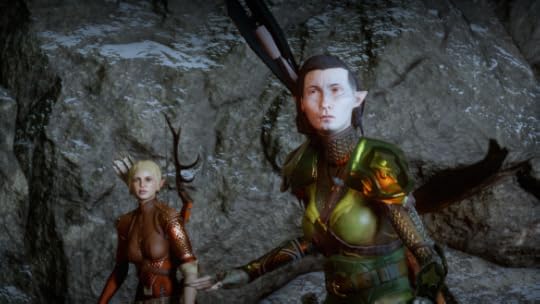 We’re in an interesting spot because the next game hasn’t been announced yet, but Trespasser gave us a pretty good picture of what it will entail. The one big question mark is who we’ll be adventuring with in the next game.
We’re in an interesting spot because the next game hasn’t been announced yet, but Trespasser gave us a pretty good picture of what it will entail. The one big question mark is who we’ll be adventuring with in the next game.
I started to ponder who I would like to see, so I now present my Dragon Age dream team. This is very much a wishlist, but I tried to make some basic concessions to realism. Balanced classes, for instance — left to my own devices, it would basically be 80% mages.
Mages:
Morrigan:
I was pondering recently why I like Morrigan so much, despite the fact that she is, shall we say, not the most easily likable person around.
It occurred to me that Morrigan is sort of like the fantasy genre personified. Her family is full of mythic figures, and she’s all about history and uncovering ancient mysteries both wondrous and terrible.
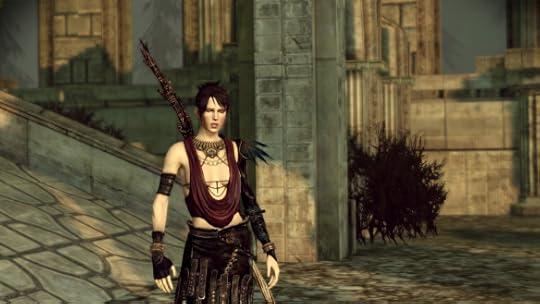 It’s that sense of history and the wonder (and terror) of the unknown that really defines the fantasy genre, and it defines Morrigan, as well. So no wonder I like her so much.
It’s that sense of history and the wonder (and terror) of the unknown that really defines the fantasy genre, and it defines Morrigan, as well. So no wonder I like her so much.
It was nice to see Morrigan again in Inquisition, but I never stopped wishing that I could ask her to come adventuring with me.
Merrill:
Merrill is history’s most adorable necromancer and the centrepiece of my favourite in-game romance arc to date, so naturally I want to bring her along.
Of course, the odds of playing as Hawke in the next game are basically nil, so I wouldn’t be able to continue her romance arc, but that’s fine. It’d still be lovely to see her again. She’s a fiercely likable character, and considering the likely subject matter of Dragon Age IV, I think her expertise would be most welcome indeed.
Calpernia:
I really wanted to put Anders here, but then I remembered Calpernia and decided she was just too intriguing an option to pass up.
 Otherwise known as “the only good reason to side with the Templars,” Calpernia is one of Inquisition’s many missed opportunities. Her role in the game is small, but in what little time she was on screen, she was established as, I think, one of the more complex and compelling characters in the franchise.
Otherwise known as “the only good reason to side with the Templars,” Calpernia is one of Inquisition’s many missed opportunities. Her role in the game is small, but in what little time she was on screen, she was established as, I think, one of the more complex and compelling characters in the franchise.
I tend to think of her as a dark mirror to Dorian, but even that might be overly harsh. Despite her role as a major antagonist — Hell, she’s the right hand of Corypheus — she comes across as a very admirable person.
Here’s someone who has lived through the absolute her country has to offer — which says a lot when your country is Tevinter — and yet she’s still a patriot. She still sees good in Tevinter wants to see it reach its full potential. It’s downright inspiring.
Considering Calpernia only appears to roughly half of Inquisition players and can potentially be killed, the odds of her appearing in later games at all, let alone as a party member, are incredibly slim. But I’d still love to see more of her.
Rogues:
Sera:
Yeah, you knew this was coming.
 Sera may be crude, undisciplined, and kind or racist, but she’s also one of the most deep and layered characters Bioware has ever come up with, which says a lot, and for all her many flaws, I find it very hard not to like her.
Sera may be crude, undisciplined, and kind or racist, but she’s also one of the most deep and layered characters Bioware has ever come up with, which says a lot, and for all her many flaws, I find it very hard not to like her.
I also have purely selfish and somewhat spoilery reasons for wanting Sera in the next game, which you will understand if you read my gushy post-Trespasser post.
…How long before I have to stop worrying about spoilers for Inquisition, anyway?
Also as I outlined in that post, Sera is one of the few characters on this list I believe to have a decent chance to show up in the next game.
Scout Lace Harding:
I personally think it’s all but guaranteed that Harding will be a party member in the next game. She seems to have been pretty popular, and I really don’t think that they snuck her into the final shot of Trespasser for nothing.
 Not much to say about Harding other than that I like her. She’s tough, but still warm and friendly. Seems like a good person to have around when things go to pieces, and I’d enjoy getting to know her better.
Not much to say about Harding other than that I like her. She’s tough, but still warm and friendly. Seems like a good person to have around when things go to pieces, and I’d enjoy getting to know her better.
Bianca Davri:
Yes, I want two fem Dwarf rogues. Why not?
Bianca’s appearance in Inquisition was brief, but memorable, and since I don’t expect we’ll have Varric joining us this time, she can fill the sarcastic Dwarf-shaped hole in our hearts. Good opportunity for a Varric cameo, too — perhaps we can learn more of their complicated history.
Warriors:
Fenris:
And again, you probably knew this was coming. It was not my intention to have an Elf of every class, but I certainly don’t mind the idea. I would love to be able to have a party made up entirely of Elves. Came close in Inquisition, with the ability to have a 75% Elven and 100% non-human party thanks to Bull.
But I digress.
 Fenris is interesting because he’s anti-mage, which normally I loathe, but in his case at least he has understandable reasons for his feelings. He’s not just blindly bigoted. Also he’s badass as Hell, and I have a man crush on Gideon Emery.
Fenris is interesting because he’s anti-mage, which normally I loathe, but in his case at least he has understandable reasons for his feelings. He’s not just blindly bigoted. Also he’s badass as Hell, and I have a man crush on Gideon Emery.
The Iron Bull:
Bull is another sad entry in the “probably won’t show up because he might be dead” file, but I’ll hold out a little hope anyway.
I’m not as big a fan of Bull as some people I know, but he’s a very hard character not to like, and since I imagine the Qunari will have a big role in the next game, his unique perspective on the Qun would be very welcome.
Plus, I did feel Bull was yet another aspect of Inquisition that didn’t get as much development as he deserved. His story always felt a bit unfinished to me. Bringing him back could help address that.
Cremisius Aclassi:
Those who know me might expect I’m including Krem to support the inclusion of a transgender character, but honestly? I just like Krem. He’s a good guy.

Skeptical Krem… is skeptical
The progressive angle doesn’t hurt any, but yeah, I just like Krem. Would like to see more of him.
Plus, the next game is likely to put a big spotlight on Tevinter, so another Tevinter character would be a good fit.
Honourable mentions:
For all their other flaws, Bioware games never lack for good characters, so there are lots more I could have included. As mentioned above, Anders is the best, and I’d love to see him again. Blackwall was a close second for the final warrior slot, narrowly beat by Krem.
Of course, I’d welcome Dorian back into the party. I mainly didn’t include him because of stiff competition in the mage category, and because of my belief his role in the next game will be comparable to, say, Leliana’s in Inquisition — important, but not a party member. Be nice to have Varric back, too, but I don’t see it happening.
I would be happy to see Bethany Hawke again, unlikely as that is. Shaper Valta would be a very interesting prospect — the first ever Dwarven mage, perhaps? And it’d be very hard to complain about venturing forth with Zevran once more.
Who you pick for the ultimate Dragon Age dream team?
Filed under: Games Tagged: because Elves that's why, Dragon Age, fantasy








January 30, 2016
TSW’s Dungeon Finder Is Transformative + Blade and Soul Thoughts
The Secret World has at last launched its long-awaited group finder tool, and I’m finding it a study in how small changes can make a huge difference in how fun a game is.
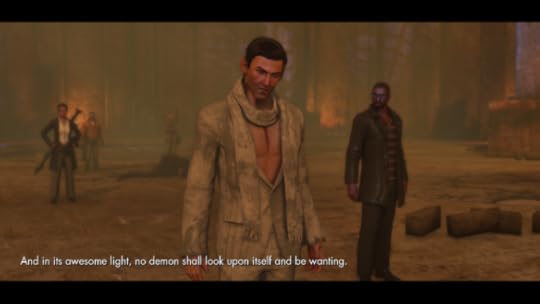 Really all the group finder does is make finding groups less time-consuming and encourage people to run a greater variety of dungeons — there’s now a daily challenge to complete a random dungeon via the group finder’s randomizer feature.
Really all the group finder does is make finding groups less time-consuming and encourage people to run a greater variety of dungeons — there’s now a daily challenge to complete a random dungeon via the group finder’s randomizer feature.
Yet this feels like one of the biggest updates TSW has ever had.
Consider that for much of my TSW career, running dungeons has been something done only very sporadically, and when I did, I basically only ever did Polaris on nightmare, plus the occasional Darkness War, Hell Raised, or Hell Eternal — and I do want to stress occasional.
Elites were worthless, with no relevant rewards at all. Non-18s nightmares were too stressful, and groups for those dungeons always mandated higher levels of gear than I own anyway.
It’s a whole other story now. I can easily find groups whenever I want — no need to muster the energy to spend an hour looking for a group — and now that elites, too, can be rewarding, the pool of potential dungeons has effectively expanded massively. I’m not stuck endlessly spamming Polaris.
I’ve done several runs with the group finder at this point, all positive, but there’s one story I’d like to particularly highlight.
 I’m getting in the habit of doing a random elite regularly for the daily challenge. It’s low stress and rewarding, reminding of running heroics back in Wrath of the Lich King so much the nostalgia is palpable. In this case, I was playing my Templar, who needs better gear to tackle Tokyo.
I’m getting in the habit of doing a random elite regularly for the daily challenge. It’s low stress and rewarding, reminding of running heroics back in Wrath of the Lich King so much the nostalgia is palpable. In this case, I was playing my Templar, who needs better gear to tackle Tokyo.
First of all, I was queued as DPS only, and the group still popped instantly. That’s amazing. That doesn’t happen in WoW, and it has a much higher pool of players to draw from. I can’t imagine how this happened, but I won’t look a gift horse in the mouth. It is worth noting, though, that while my other queues have not been instantaneous, they have all been very fast — five minutes at most.
We zoned into the Slaughterhouse, which is a dungeon I haven’t run in over a year, at least. It was a perfect sweet spot where I mostly remembered the mechanics, but it still felt almost new to me.
I had forgotten that TSW actually has great dungeon design. My complaint was always the difficulty of finding groups. But now I’m reminded that its dungeons boast fantastic art design, fun and interesting mechanics, and strong stories that don’t interrupt gameplay.
I think, also, that the stress of finding groups always robbed some of the fun from the experience. By the time I got into the dungeon, I was usually exhausted and frustrated from the time spent gathering a group, and the thought of how hard it would be to find another if this group broke up was a constant anxiety in the back of my mind. That’s no longer a factor.
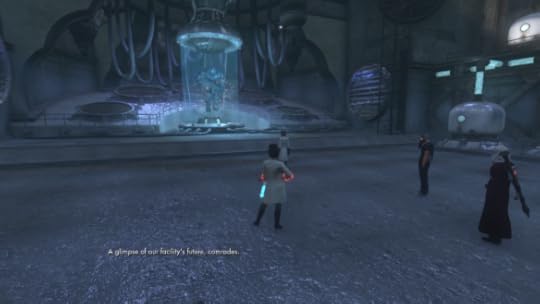 It was a good run. The tank explained the more important mechanics for those of us with rusty memories, and since we overgeared the place a bit, it was all fairly relaxed. One person DCed at one point, but the group finder eventually replaced with them — with no input from us, even — and we did okay without them in the meanwhile.
It was a good run. The tank explained the more important mechanics for those of us with rusty memories, and since we overgeared the place a bit, it was all fairly relaxed. One person DCed at one point, but the group finder eventually replaced with them — with no input from us, even — and we did okay without them in the meanwhile.
At the final boss, things got interesting.
A mechanic bugged out and killed our tank early on. Automatic wipe, right?
Apparently not.
It turns out our healer was some kind of demigod. Picture three DPS running around like chickens with our heads cut off while the healer somehow kept us alive through it all. I had resolved to merely go out fighting, but the battle kept going, and somehow, we endured.
Phase two starts. One DPS falls. The remainder of us come within inches of death several times. But the healer keeps bringing us back from the brink, and the boss’s health keeps going down. The tank is joking and cheering us on from back at the anima well.
And we did it. Our four-man, no-tank group triumphed.
Healing is disgustingly overpowered in this game. And I’m okay with that.
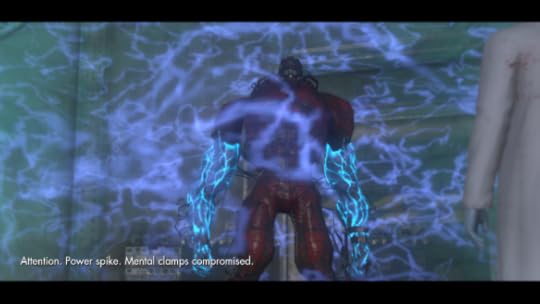 Afterward, we were all laughing and cheering. It was the most fun I’ve had in The Secret World — or any game — in a long time.
Afterward, we were all laughing and cheering. It was the most fun I’ve had in The Secret World — or any game — in a long time.
And it never would have happened without the group finder.
I still need to try running low level dungeons and the new Tokyo dungeons. I’m a little concerned because there’s bound to be far fewer people running low level dungeons, and I’ve heard a lot of horror stories about the Tokyo instances.
But even so, the dungeon finder is still a huge boon for the game.
I’ve long said that TSW is a fantastic game when treated as a single-player RPG with optional co-op, but that it fails as a massively multiplayer game. The first half of that sentence is still true, but now, finally, it is also a strong contender as an MMO.
I am, simply put, very happy with where the game is at.
* * *
Since we’re on the subject, TSW is enacting major changes to its subscription rewards program. As part of this, they will no longer be selling the grandmaster pack lifetime subscription as of February 5th. Until then, it’s on sale for 25% off.
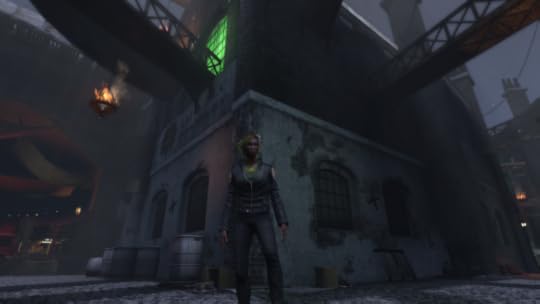 I know $150 is a lot to spend on a video game, but I will say that I have been a grandmaster for over a year now, and I’ve never once regretted it. With the new subscription rewards, it’s also now a better deal than ever. If you’re on the fence, I’d advise you to get it now while you can.
I know $150 is a lot to spend on a video game, but I will say that I have been a grandmaster for over a year now, and I’ve never once regretted it. With the new subscription rewards, it’s also now a better deal than ever. If you’re on the fence, I’d advise you to get it now while you can.
Blade and Soul impressions:
While I wasn’t as rabidly excited as some, I’ve been interested in Blade and Soul for several years now. Now that it’s finally arrived in North America, I made a point to check it out as soon as the launch rush died down a little.
My thoughts are up on MMOBro, but suffice it to say Blade and Soul is not what I was expecting.
While you’re there, why not check out my other recent articles on the site? Find out why MMO NPCs need more Witcher and less Skyrim, or learn which MOBA is right for you.
Filed under: Games, My writing Tagged: Blade and Soul, fantasy, The Secret World, writing








January 27, 2016
Review: Dawn of the Planet of the Apes
Dawn of the Planet of the Apes is another movie I missed out while I was living out in the middle of nowhere, but thanks to Netflix, I have now caught up.
 The previous movie was somewhat imperfect, but still enjoyable on the whole, and Dawn of the Planet of the Apes is pretty much the same. It’s more well put together than Rise was, but still ultimately unsatisfying in some ways.
The previous movie was somewhat imperfect, but still enjoyable on the whole, and Dawn of the Planet of the Apes is pretty much the same. It’s more well put together than Rise was, but still ultimately unsatisfying in some ways.
For Dawn, the plot jumps ahead ten years and goes full post-apocalyptic. Most of the human race has been wiped out by the so-called “simian flu,” to the point where the apes believe humans are extinct altogether.
The apes, on the other hand, have prospered, and led by Caesar, they have begun to build their own society in the wilderness of California.
Caesar and the orangutan Maurice are the only characters to return from the first movie, though I doubt anyone’s complaining, as the human cast members were by far the weakest link of Rise of the Planet of the Apes.
Things change when a group of human scouts stumbles into ape territory, hoping to reactivate an old hydro-electric dam to power an enclave of survivors. Relations between apes and humans are initially tense, but Caesar hopes to come to an understanding with the humans, and he finds a kindred spirit in a human named Malcolm and his family.
 But there are elements on both sides who are distrustful. The biggest obstacle to coexistent between human and ape comes from Koba, a lieutenant of Caesar’s who was tortured by human medical experiments in the past and wants nothing more than to make humanity suffer.
But there are elements on both sides who are distrustful. The biggest obstacle to coexistent between human and ape comes from Koba, a lieutenant of Caesar’s who was tortured by human medical experiments in the past and wants nothing more than to make humanity suffer.
Dawn of the Planet of the Apes wisely puts a greater emphasis on the apes than its predecessor, and they remain the more interesting and developed half of the plot, but this time the humans are not so flat and lifeless, and they also prove a worthy contribution to the story.
There are also a lot less things in this movie that are, well, stupid, compared to Rise. There are still some implausible or ridiculous things — Caesar seems to have Wolverine-levels of healing ability, and the size of the ape population seems to vary based on the needs of the plot at any given moment — but on the whole it’s a much more well-written story.
However, the themes and arc of the story are a bit confused. It often seems to be wanting to tell a morally gray story, with neither the apes nor the humans being entirely good or evil, but in practice it does tend to make the apes out to be bad guys more often than not. Ultimately Caesar and Maurice are the only decent apes.
It makes the movie a bit hard to get invested in, because the apes are the focus and the main characters, but they’re also the villains. It’s… odd.
Perhaps because of this, I found the story somewhat unsatisfying. The ending is neither pleasant nor conclusive.
Overall rating: 7.3/10 Like its predecessor, it’s an interesting but flawed movie.
Filed under: Reviews Tagged: Dawn of the Planet of the Apes, movies, review, sci-fi








January 24, 2016
So iZombie Is Pretty Good
Here in Canada, a new streaming service — like Netflix but not Netflix — called shomi has been offering a two month free trial, so I figured I might as well check it. Price is right, after all.
 I wouldn’t say shomi is any better than Netflix, or any worse. Both have fairly limited selections (Canadian Netflix is a pale shadow of its US incarnation). But importantly, there isn’t a lot of overlap between their selections, so I’ve been enjoying shomi purely as a source of variety.
I wouldn’t say shomi is any better than Netflix, or any worse. Both have fairly limited selections (Canadian Netflix is a pale shadow of its US incarnation). But importantly, there isn’t a lot of overlap between their selections, so I’ve been enjoying shomi purely as a source of variety.
In addition to finally catching up on Vikings, I decided to give iZombie a try, having seen a few ads for it and been mildly curious.
As it turns out, it’s actually pretty good.
iZombie is the story of Olivia “Liv” Moore, a bright, over-achieving young medical student who has been dead for about six months.
Liv had the misfortune to be caught in a sudden and inexplicable zombie outbreak. One scratch and some light drowning later, and she is now possessed of an unusually pallid complexion and some rather extreme new dietary requirements.
She now works in a morgue for easy access to fresh brains. After eating a brain, she gains the person’s memories and some of their personality, and she begins helping the police solve crimes using these stolen memories. Her cop partner is of the impression she is an emo psychic, which explains her pallor and her visions.
 It’s weird. But fun.
It’s weird. But fun.
iZombie is a hard show to define. If I had to give it a label, I’d call it a comedy, but it also has elements of drama and mystery and at times resembles a cop show or a superhero story. It’s based on a comic book, so it is, well, very comic book-y.
It’s not a series with a whole lot of depth, and there some parts of it that you just shouldn’t think too hard about — such as the incredibly lax security at the police station morgue — but it’s plenty entertaining.
The characters are likable — especially Ravi, Liv’s disturbingly eager accomplice in all things undeath-related — and it’s just so odd it’s hard not to appreciate. Where else can you find gems of dialogue such as, “You ate the woman’s temporal lobe. The least you can do is help find her killer.”
Also plenty of little in-jokes. I mean, she’s a zombie, and her name is Liv Moore. I see what you did there, iZombie.
To be fair, I’ve only see a couple of episodes so far, but I haven’t seen a bad one yet. “Live and Let Clive” was a little weak, but worth it for Liv’s instant kung fu, progression of Blaine’s plot, and Major and Ravi geeking out over Diablo III.
 So if you haven’t seen iZombie yet, I would definitely recommend checking it out. It might not be Shakespeare, but it’s funny, entertaining, and very different.
So if you haven’t seen iZombie yet, I would definitely recommend checking it out. It might not be Shakespeare, but it’s funny, entertaining, and very different.
* * *
By the way, if you’re wondering why I’m not doing my usual battery of reviews for this show, the simple answer is I don’t want to. For the most part I enjoy maintaining this blog, but having to come up with a ~500 word review after every episode of a show can at times feel a little burdensome.
iZombie is an ideal show for relaxation — light-hearted and largely uncomplicated — and I didn’t want to spoil that by having to get into a work headspace after every episode.
But it’s a good enough show that I wanted to give it a shout out. It’s worth your time.
…Now I’m wondering what would happen if Liv ate my brain. Probably she’d just start tripping and dropping things more, and bore everyone around her to death with constant chatter about Elves.
Filed under: Misc. Tagged: iZombie, TV








January 21, 2016
Rage of the Old Gods, Epilogue: The Next Journey
Well, this is it. The end at last. I hope you’ve enjoyed the story so far, and if you’re just joining us, you can get caught up with the previous chapters now.
 With the war over, the time has come to pick up the shattered pieces of civilization. The next journey is at hand.
With the war over, the time has come to pick up the shattered pieces of civilization. The next journey is at hand.
———————
Epilogue: The Next Journey
The ceremony began.
The crowd hushed as Yarnig approached from their left. In the distance, the rush of the river could be heard. Yarnig’s boots crunched on the blackened gravel beneath his feet, all the remains that the machines had left behind after Retgard’s abandonment.
He felt oddly relaxed. All he had to do was speak well, and that was the one aspect of leadership he was skilled at. He wore the finest clothes he had been able to find, and a circlet of gold – a replica of the one that had been lost with the death of Empress Lorganna – sat upon his head.
He came to stand before the center of the crowd, beside a kneeling figure in polished chain mail and fine furs. The crowd spread up the side of the valley, arranged so that they all had a view of the ceremony. Leha, Drogin, Doga, Benefactor, and Natoma stood in the front row, smiling.
Yarnig faced the assembly. “First, there came the Tor Sinnis, the Tor Makers, who led our people away from oppression and founded this nation. Then came the Tor Vargis, the Tor Liberators, who freed our people from the rulership of the Northern Clans. And finally, the Tor Lannis, the Tor Defenders, who broke the power of Jansia and made Tor Som one of the great nations of the world.”
He lowered his voice, dropping his eyes mournfully. “Then, when the Automatons rebelled, our nation was shattered, and our leaders were wiped out. Only I, the last scion of the Tor Lannis, survive, and I have never been prepared for the burdens of leadership.”
He brought his gaze up to face the crowd, slowly raising his voice. “I cannot lead our people into the future.” Solemnly, he reached up and removed the circlet from his head. “Perhaps the day will come when my line shall again lead, but it is not today. I hereby abdicate the throne of Tor Som.”
He turned to the kneeling form at his left. “But there is another with the strength and the wisdom to bring our nation into the future. Today, we begin a new dynasty,” he said, his voice echoing through the mild autumn air. He reached down and placed the circlet upon the pale hair of the kneeling figure. “I crown Eranna Tor Kellis, the Tor Savior, empress of all Tor Som!”
The crowd erupted into jubilation.
Leha clapped and cheered.
“Hail Eranna!” Doga shouted, his deep voice booming, and many in the throng echoed his words.
Eranna came to her feet, holding up a polished spear. “Thank you. I promise that I will do all I can to ensure that our nation recovers from the horrors of the past year. Tor Som will rise again, my friends.”
The people cheered louder.
Yarnig applauded his successor, feeling a burden lift from his shoulders.
* * *
The celebration lasted throughout the day and into the evening. The sun disappeared behind the rim of the valley, and the stars came out above, and still they celebrated.
The celebration was not just for Tors. The coronation of Empress Eranna constituted the first step towards rebuilding the lives that people had before the rebellion of the Automatons. This brought them all closer to reclaiming what they had lost. Thus, Tors, Eastenholders, Karkarans, Urannans, Clanspeople, and even a number of Lost Ones and ice creatures all joined in the merriment.
For Leha, circulating through the gathering and sipping her ulu and brandy, it seemed a magical night. It was a chance to relinquish the burdens of leadership and simply enjoy herself, something she had not done in a very, very long time. The air was cool without being cold, and the stars were bright. If the night had been crafted to be pleasant, she didn’t think it could have been better.
There was little food to be had, but that didn’t matter to the revelers. The chance to enjoy each other’s company, and to do so without fear, was worth more to them than a thousand banquets.
The festivities also brought the chance to enjoy something else that had been all too rare over the past year: music. During the struggle with the Automatons, there had been little time for music, and even in the few moments of peace, no one had felt much like playing, or listening. But now things were different. Now, they had both the time and a reason to enjoy themselves.
Most of the musicians and instruments of the other nations had been lost in the war, so the music came courtesy of the Clanspeople. Their music, played primarily with large drums and horns, was loud and booming while still being harmonious and melodic. Smaller wind instruments provided subtle undertones to the songs.
Leha danced for what felt like hours. She danced with Drogin and with Lahune, and she and Doga taught each other the dances of their respective worlds. Once, near the end of the night, she even danced with Yarnig.
Afterward, she thanked the young Tor for saving her life after the battle with the Automaton Lord. He smiled, seeming to enjoy the compliment. She watched him go, thinking of how much he had changed since she had first met him. He had a purpose now, she saw. He was not just a lost boy anymore.
Those at the celebration spoke much about the future. The trials of the past months had necessitated the loss of many social inhibitions, and there was no separation between high and low-ranking individuals at the celebration, so Leha was privy to all the discussions.
The Tors mostly talked of rebuilding their nation. They wistfully described the beauty that their cities had once had, and they speculated on how things would change with the reconstruction. They talked of resuming their lives, of again farming and doing business.
The Karkarans also planned to rebuild their nation. Some had already headed south to begin the work.
The Eastenholders seemed divided. Many were eager to return home and rebuild what the Tors and Automatons had destroyed, but others believed that it would be better to move forward and find a new homeland. So much of the world was now unclaimed.
Many Eastenholders believed that they needed to reform their government, to elect a new magistrate. All agreed that, in such a contest, Leha would be chosen in a heartbeat. She tried to steer them away from that idea. She had no intention of accepting new responsibilities. Besides, she reasoned, she knew little of law or governance.
The Clanspeople had lost the least to the Automatons, and they did not have much recovering to do. Their lives would change little. However, there would be one major change for them. To Leha’s delight, they had negotiated an agreement with the Tors that would not only see them open trade but also allow the Clanspeople to make use of the northern reaches of Tor territory, land that had belonged to the Clans before the Tors had claimed it as their own.
Members of all nations talked of going south, to Uranna. Most of the country’s once vast population had been killed, and a host of people were eager to resettle the clement, fertile land.
Lahune said that he planned to stay wherever populations were high. Recent events had rendered people more open to his order’s teachings, and he planned to make the most of it.
Most of the Lost Ones and ice creatures would be returning to their worlds to aid in rebuilding what the machines had destroyed – many had already done so – but others, especially among the Lost Ones, had become enamored with Barria and would be staying. Some hadn’t decided.
Late in the festivities, Leha took Doga aside and asked what his plans were.
“I’ll be staying here for the moment,” he said. “I plan to help Eranna rebuild her country. I learned much about logistics and organization while we fought on the northern front. I should be able to help.”
Leha nodded.
“After that, I am not sure. I miss Tyzu, but I want to see more of Barria. I want to see it without the pall of war obscuring my vision.” He breathed in the cool air and gazed up at the stars. “For seven thousand years, every Lost One has dreamed of visiting Barria. I’m not eager to leave.”
She nodded again, trying to imagine what it had been like to be cut off from humanity’s homeworld.
He peered down at her. “What about you? What are your plans for the future?”
“Natoma and I are planning to head south,” she said, her voice slightly slurred by the brandy. “There are survivors in Pira, Karkar, and Uranna, and they need to know the war is over. They need to know that there are other humans out there who can help them. We’ll take a small group and find everyone we can.”
“Many people scattered when the machines rebelled. It may take years to find them all,” he said.
She agreed. “We won’t be able to search everywhere, but we’ll do what we can. Benefactor wanted to come, so we’ll be able to use his telepathy to look for nearby minds.”
“When will you leave?”
She shrugged. “In a week or two. There are a few loose ends that need tying up first.”
He wished her good luck with her journey, and she thanked him.
He asked if she wanted to dance again, but she refused, citing her tiredness and the effects of the brandy.
Sometime after midnight, with parts of the celebration still going, Leha found her way to her to tent and fell into a deep, dreamless sleep.
* * *
The cool air whipped past Yarnig’s face as he rode up the lane, his horse’s hooves pounding on the unpaved dirt. The road had been neglected for the better part of a year, and leaves and detritus covered it, but it had not yet become impassable.
Trees lined both sides of the road, their branches occasionally arching overhead to provide shade. This far north, the leaves had already begun to change, and the bright sun reflected off reds, yellows, and oranges as well as the green of the leaves that had not yet begun their metamorphosis. The scent of fallen leaves filled his nostrils as he rode.
He could have made this trip by jumping point, but he relished the opportunity to ride through these woods again. Every smell and sight brought back pleasant memories of his youth.
As he looked about him, he saw no signs of Automaton-inflicted damage. He took some hope from that. The nearby town of Timbrocken, where he had jumped in, had been flattened. But the machines had not had time to completely scour the world of human influence, and there had been reports of isolated homes or settlements surviving.
Ahead, the road forked. He took the right fork, grinning as he tore around the bend.
Yarnig had planned to come here for months. The notion had been at the back of his mind since Leha had ordered the settlements abandoned, and once the war had ended, he had promised himself that he would make the journey.
Healing wounded and helping with the recovery had kept him busy for days after the battle at the camp, and then the journey back to Tor Som had kept him distracted for several more weeks. Now, he had started to help in the reconstruction of Retgard, but Eranna had allowed him time for this personal journey.
He spotted a pair of gates ahead, and his heart skipped a beat. They appeared intact.
He brought his horse to a halt and dismounted. He stepped forward. The gates were made of iron and spanned the distance between two pillars of stone. They were remarkably simple for something owned by a royal family and bore little adornment. They were a bit rustier and more weather-beaten than he remembered, but they were otherwise undamaged. Lines of tall evergreens, planted many years ago by servants of his ancestors, extended from either side of the gates, delineating the edge of the lands owned by the Tor Lannis family.
Beyond the gates, Yarnig could see the roof of his country home.
Behind him, Yarnig’s companion reined in her horse and dismounted, streaks of blue touching her hair as the sun glinted off it.
“Is this it?” Natoma asked, hitching their horses to a tree.
He nodded. “Yes.”
He produced a key from his pocket and unlocked the gates. They swung open with a whine, and Yarnig and Natoma stepped into the courtyard.
The country home stood ahead of them. Like the gates, it was very simple by royal standards. This place had been built as a place to retreat from the burdens of court, and its builders had not wanted a reminder of their rank and responsibilities. It was a large dwelling, but it was far from a palace. The months of abandonment had left it in need of some maintenance, but it seemed largely undamaged.
To their left, a building that had once housed servants stood in a similar state of disrepair. To their right, the wind whistled through an abandoned stable.
Out beyond the country home and a few small outbuildings, the vast forest stretched into the distance, the trees sighing to each other.
They moved forward, taking in the sights.
“This is where you grew up?” Natoma said.
“Yes,” he said, striding across the leaf-covered stones of the courtyard. “We spent most of our time in the palace in Retgard, but this is where all the good things happened.”
She breathed deeply. “It’s beautiful.”
He glanced about, smiling wistfully. “Yes, it is.”
He went to the front of the home, opened the door, and went inside. He moved through the rooms, inspecting them to see how they had weathered the past months. Natoma entered a few moments after him, following a path slightly different from his through the house. The air smelled of dust and mold, and he noticed signs of mice and other vermin, but no severe damage had been done to the place.
“It isn’t too bad,” he called to Natoma from a guest bedroom. “A few weeks work should be enough to restore it.
She strolled into the doorway behind him. “Do you plan on coming back here permanently?” she asked.
He turned to face her. “I don’t know.” He went to the room’s window and looked out. “I love it here, but it will be very isolated until the countryside is repopulated, and I’m needed in Retgard.” He considered. “I suppose that’s where I’ll stay for now. But I want to come back here one day. Soon, hopefully.”
They resumed their exploration of the home. Yarnig lost himself in memories of the past.
Sometime later, he found himself in one of the sitting rooms, the one in which he had first thought of traveling north to contact the Clans. He went to the far wall and found the map that he had stared at all those months ago. He wiped a thin layer of dust from it and considered the blank stretch that represented Clan territory.
He heard Natoma come in. “Who is this?” she asked.
He turned around. She stood before a sketch of a woman with pale, flowing hair and noble, elegant features. Yarnig’s servants had brought much of his artwork with them when the place had been abandoned, but this one had been left behind.
“My mother,” he said, coming to stand next to her.
Natoma glanced at him. “I can see the resemblance.”
He nodded.
“Have you decided whether you’ll be coming yet?” she said after a moment. She referred to Leha’s mission to the south.
He sighed. “I don’t think that I can. They need my abilities in Retgard.”
She turned to face him, nodding understandingly.
“But you’ll be jumping back for supplies regularly, right? We should still be able to see each other,” he added.
She smiled warmly. “Yes, we will.” She kissed him.
He returned her smile.
She collected the portrait of his mother, and they left the home together, hand in hand.
* * *
They arrived in a flash of green-white light, briefly illuminating the ruins of Three Gates.
Leha, Drogin, and Eranna stood in what had once been a square. The homes and shops that had surrounded it were now nothing more than charred rubble and broken foundations. The sun shone almost as brightly as it had on the day of the city’s death, and a light wind ruffled their clothes. The air was silent, and their breathing sounded loud.
They began to move, picking their way through the rubble, saying little. They soon split up, each going to confront the past in their own way.
It had been Leha’s idea to come. The idea of traveling here to put the past to rest had been in her mind for weeks now. One night, she had suggested it to the other two, and they had taken to the idea.
None of them had set foot in the city since its fall. They had passed by it on their journey to Tor Som after the Battle of Heart, but the Tor army had already looted it of useful supplies, so there had been no reason to enter it. At the time, Leha had wanted to avoid the ruins and the memories they brought up. She suspected the others had felt the same way.
As she made her way down the rubble-strewn streets, Leha realized she hardly recognized anything. Almost nothing was left standing, and little of the remains were identifiable as what they had been.
She supposed it was surprising that this much remained. The Automatons had ground the cities of the other nations into nothing but dust and pebbles, but they had been far less thorough with the Eastenholder settlements. They hadn’t had time in the early days of the war, she guessed, and her people had abandoned the country, so the machines had probably decided the scouring of Eastenhold could wait. She didn’t doubt that they would have done it eventually.
Here and there, she spotted pieces of white bone. She shuddered.
She hoped she had done enough. She hoped nothing like this would ever happen again.
At last, she came to something too familiar not to recognize: a rectangular foundation filled with enough rubble to indicate that the building had had a second floor. Her shop. Her home.
She stepped through what remained of the doorway. Numbly, without thinking about what she was doing, she began to sift through the rubble. The sound of stone against stone echoed eerily in the quietness of the ruins.
She moved a large chunk of brick, and something glinted. She reached down and retrieved the object. It was the Urannan mirror she had removed from the window on the day of the attack. Its glass had been cracked, and its frame was scuffed, but it was in surprisingly good condition otherwise.
She studied her reflection.
She didn’t look as she had on the day of the attack. Her face remained youthful, but her eyes, with their deep blue pupils, lacked the sparkle they had once held, and her longer hair made her look older.
She noticed a small scar beneath her right eye. She ran a finger along it, trying to remember how she’d gotten it. She couldn’t.
She sighed and set down the mirror. With one hand, she collected her hair at the base of her neck. She sent a small amount of acid trickling down one claw of her other hand, and in one quick motion, she burned through her hair, leaving it shoulder length.
She retrieved the mirror. Her hair now formed a frame around her face, barely reaching her shoulders, as it had before the war. She put on a smile, and in the reflection, she almost looked like she once had.
She continued to rummage through the ruins, but she found little. Her books had been consumed by fire, and most of her artifacts and trinkets had been smashed.
In the end, she left it all behind.
As she made her way back, she encountered Eranna. The Tor’s eyes widened slightly when she noticed Leha’s hair.
Eranna asked a few questions about what she had been doing, and Leha briefly described the return to her shop. They fell silent for several long moments.
“I used to have dreams about this,” Eranna said, gesturing at the shells of buildings.
Leha glanced at her questioningly.
“I dreamed about the battle,” she explained. “In my mind, it melded with the battle in the Mannall Range, and sometimes with other battles as well. Whenever I closed my eyes, I saw the fire, the blood.” Her eyes stared at something Leha couldn’t see.
“Do you still have them?” Leha asked.
Eranna shook her head slightly. “They’ve been getting less frequent since we won the battle at the camp. I haven’t had one in a few weeks. I’m hoping that they’re gone for good.” She managed a smile.
Leha squeezed her arm gently.
When they returned to the square they had jumped in at, they found Drogin waiting for them. He carried a small sack in one hand. He showed Leha its contents: a small bronze sculpture of General Phanto and a few other items from his home.
They took one last look at the ruins, and then Drogin raised his wand. Green-white light flashed around them.
* * *
Eight days later, early on a frosty autumn morning, Leha and the others who would make the journey south began the final preparations for departure.
The Clanspeople had constructed several hovering wagons specially for the journey. Having already been stocked with food and weaponry – there was always the risk of encountering Automatons that had evaded the hunting parties – the wagons were hitched with their teams of reindeer and brought to the edge of the valley that Retgard sat within.
A tingle of excitement ran through the air. Leha smiled often, looking forward to seeing more of the world, even in its ruined state, and Benefactor twitched eagerly, baring his dark teeth.
Leha felt a kind of cheer that she had not in a long time. Since her journey to Three Gates, the pain of the past had not seemed so strong.
A great crowd gathered to see them off, waving and calling out good wishes. They stayed at a respectful distance to allow the members of the party and those close to them to say their goodbyes privately.
Leha joked with Lahune about how their lives continued to interfere with their recording efforts. Then she and Drogin shared a long hug, saying their heartfelt goodbyes. Yarnig and Natoma stood close to each other and shared a few hushed words of farewell. Doga and Eranna went among the members of the party, wishing them good luck. The other members of the party bade farewell to their friends and family.
The time came for them to leave. Leha and the others boarded the wagons, still calling out final words of parting. The reindeer began to move, and the wagons set off down the road to the south, the sun shining brightly upon them.
The next journey had begun.
———————
If you’ve enjoyed Rage of the Old Gods, I encourage you to show your support by purchasing a copy for yourself or a friend. Smashwords ebooks are DRM free, so you can share them as you please.
Also, I currently have no plans to release any free chapters of the next two books beyond the free previews currently on Smashwords and Amazon. If you want to see the continuation of Leha’s adventure, I encourage you to check them out.
In Children of the Gods, our heroes must face the dark legacy of the Old Gods when a heretofore unknown offshoot of humanity lands on the shores of Pira. Leha must defend her people, but in so doing, she betrays everything she has fought for. Will humanity’s survival come at the cost of its soul?
And in Human Again, a haunted Leha must confront the cost of her gambles: an entire universe of worlds ruined by her mistakes. Can she withstand such horrors? Can the saviour of humanity save herself?
Filed under: My writing, World Spectrum Tagged: books, fantasy, Rage of the Old Gods free chapters, sci-fi, steampunk, The World Spectrum, writing








January 18, 2016
Review: Grey Goo
It saddens me to no end that the RTS genre has fallen to the wayside as it has, so I try to snap up any decent-looking one I can find.
Enter sci-fi RTS Grey Goo.
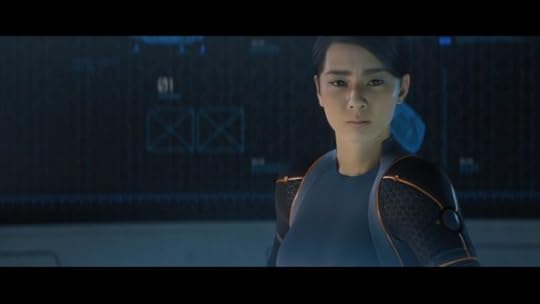 I’ll say upfront that this review focuses on the single-player campaign. I’ve heard it said that the multiplayer community for Grey Goo is virtually nonexistent, and I didn’t have much interest in playing it competitively anyway.
I’ll say upfront that this review focuses on the single-player campaign. I’ve heard it said that the multiplayer community for Grey Goo is virtually nonexistent, and I didn’t have much interest in playing it competitively anyway.
Grey Goo centers on the conflict between three races: a ragged group of alien refugees called the Beta, a hyper-advanced far future version of humans, and the titular all-consuming nanotechnology.
Interestingly, we first experience the game through the eyes of the Beta, not the humans. The Beta have spent generations fleeing across the stars to escape something called “the Silent Ones.” When hostile probes begin appearing on their world, they fear the Silent Ones have found them again, but the new threat is discovered to be something altogether alien to the Beta — though rather familiar to players.
And through it all is the rising danger of the Grey Goo, a ravenous breed of nanotechology consuming all in its path to attain some unknown goal.
Based on the setting and the trio of races, I had expected Grey Goo to be something of a StarCraft clone, but it turns out to play more like the old Dune or Command and Conquer games. I have since learned a lot of former Westwood people worked on Grey Goo, so that explains that.
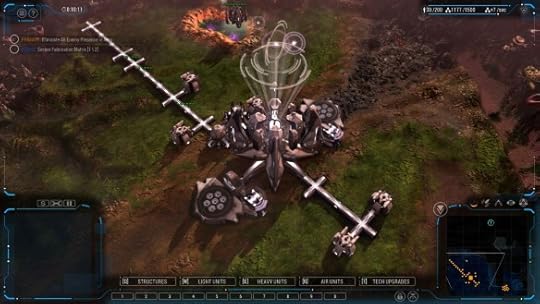 It’s not my favourite style of RTS, but with the genre flagging as it is, beggars can’t be choosers, and it’s been so long since I played a game in this style that there was something pleasantly nostalgic about it.
It’s not my favourite style of RTS, but with the genre flagging as it is, beggars can’t be choosers, and it’s been so long since I played a game in this style that there was something pleasantly nostalgic about it.
There’s just one resource to gather, catalyst, and the races aren’t terribly distinct. Beta and humans play pretty much the same with only subtle differences.
The Goo are a bit different. Their units are still fairly similar to those of other races in a lot of cases, but there are more deviations (the Goo, for instance, cannot field air units), and their economy is completely different. There are no structures, only protean blobs of Goo that then transform into units.
Each race can also field epic units, which are akin to Age of Mythology’s Titans. They are very difficult to create, but nearly unstoppable once produced. Although Goo were my least favourite race to play, their epic unit, the Purger, was the most fun for me. Nanotech Cthulhu.
This is a rare case where I actually liked the humans best. An interesting twist is that in Grey Goo, humanity plays the role of the super advanced aliens, with the Beta technology being far more basic and rough around the edges. At one point a human dismisses the Beta as primitives by saying, “They’re still using bullets in their guns.”
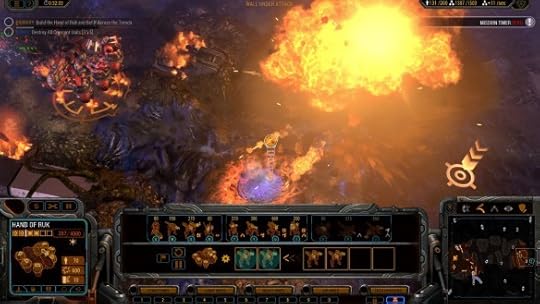 I mostly enjoyed the campaign, but it does suffer from two major flaws, which sort of feed off each other.
I mostly enjoyed the campaign, but it does suffer from two major flaws, which sort of feed off each other.
The first is that it’s very short. There are only five missions per race, and I was able to finish the entire campaign within ten hours.
As a result, it can also be quite rushed. There isn’t enough time to fully flesh out the characters or develop the story arcs.
The other issue is that this is one of those games that really throws you into the deep end and hopes you learn to swim. This is true of both the gameplay, as Grey Goo does offer a relatively steep learning curve, and the story, which throws you right into the middle and leaves you to try to figure out what’s going on. It took until midway through the final campaign for me to get a clear picture of Grey Goo’s backstory and what was really going on. This is undoubtedly the result of how small the campaign is.
There’s a DLC campaign, Emergence, to help flesh things out, but it’s quite brief, so while it does add some welcome insight into the events of the campaign, it doesn’t do much to help the game’s length issue. It’s also very difficult and thus somewhat frustrating.
 There are a few other hiccups, as well. The mission design is old school in the extreme, with nearly every mission being some variation of “go destroy the enemy base.” The difficulty is a bit oddly tuned, too, with some missions being fairly simple, but others, especially near the end, being incredibly frustrating even on the easiest difficulty setting.
There are a few other hiccups, as well. The mission design is old school in the extreme, with nearly every mission being some variation of “go destroy the enemy base.” The difficulty is a bit oddly tuned, too, with some missions being fairly simple, but others, especially near the end, being incredibly frustrating even on the easiest difficulty setting.
That said, once you finally figure out what’s going on, the story of Grey Goo is pretty interesting, with some good twists and excellent use of its core sci-fi concepts.
This is definitely not the same style of sci-fi StarCraft is — IE just fantasy with space ships and guns — but a game that is serious about its science fiction. Grey Goo is about as close to hard sci-fi as I’ve yet seen in a video game. Which still isn’t that close, but still.
Putting aside the issues mentioned above, the storytelling is of a high quality. Cutscenes are frequent and spectacular, and the voice acting is very strong.
Despite some stumbles, I would like to see a sequel or expansion to Grey Goo. There’s a really interesting premise here, and the world needs more quality RTS games.
Overall rating: 7.3/10
Also, because I can:
 I’ve only ever seen one episode of Archer. The ants thing was the only part that made me laugh.
I’ve only ever seen one episode of Archer. The ants thing was the only part that made me laugh.
Filed under: Games, Reviews Tagged: Grey Goo, review, sci-fi








January 15, 2016
Review: Star Wars: The Force Awakens
I had previously resolved not to see Star Wars: The Force Awakens, on the principle of “fool me six times, shame on you; fool me seven or more times, shame on me.” My feelings on Star Wars are known by now. I think the movies are, for the most part, childish and ridiculous.
 I also have a pronounced dislike of JJ Abrams.
I also have a pronounced dislike of JJ Abrams.
But the smartest person I know — who is also not traditionally a Star Wars fan — liked it, and frankly, I wanted an excuse to have popcorn for lunch.
First of all, let me say that this is still very much a Star Wars movie. And by that I mean it views logic, continuity, and common sense as optional frills and frequently interrupts the already thin plot for yet another over the top spew of (admittedly excellent) special effects.
There are so many things about this movie that are utterly ridiculous or make no sense at all — not even movie sense. I couldn’t even begin to list them all, though I would especially like to highlight the First Order’s incredibly liberal definition of “fifteen minutes.”
Much of the Force Awakens’ stupidity results from its endless need to make shameless and unnecessary plays to nostalgia. I’m not sure I entirely agree with those who say that this is purely a retreat of A New Hope, but it does feel that way at certain points.
By far the most egregious example is the fact they built another Death Star.
What is it with these Dark Side types and their Death Stars? Lordy, I thought I had a one track mind.
 It’s like Terry Brooks with the damn Blue Elfstones. Just stop. There are other plot devices out there!
It’s like Terry Brooks with the damn Blue Elfstones. Just stop. There are other plot devices out there!
And just like the original Death Star, it destroys worlds and kills millions in a cataclysmic attack that is forgotten by every character within five minutes and has no significant impact on the story.
However, not every nod to the past is a negative. Both Harrison Ford and Carrie Fisher reprise their original roles, and perhaps the biggest surprise for me out of the whole movie was how incredibly good they both were.
Both show a great vulnerability, and they’re very convincing as a pair who have simply suffered too much and lost too much. It’s kind of heartbreaking, honestly.
Han still has all of his cockiness and sarcasm, but it’s clear it’s now just a shell he’s built around his pain. There’s a definite fragility to it.
However, the real strengths of The Force Awakens are where it stops riding the coattails of its predecessors.
 For all its many flaws and unabashed stupidity, there is one major highlight to the seventh Star Wars film.
For all its many flaws and unabashed stupidity, there is one major highlight to the seventh Star Wars film.
Her name is Rey.
Now, I can understand why people call her a Mary Sue. She pretty much is, but that’s kind of par for the course in Star Wars. It’s meant to be a very larger than life, mythic story. So it fits for Rey to be amazing at pretty much everything.
Either way, she’s impossible not to like. Daisy Ridley plays her with an irresistible combination of toughness, vulnerability, and charisma. Despite her admitted Mary Sue-ish traits, she still comes across as a very human character, and watching her grow and evolve over the course of the movie, defying the expectations of those around her at every turn, is a complete joy.
This is something that hasn’t really existed in Star Wars before: competent acting. Not just competent — excellent, even. I’m very impressed by the subtleties of Daisy Ridley’s performance. She’s able to communicate a lot of inner turmoil and growth with just subtle facial expressions and changes in her tone of voice.
Rey is definitely the star of The Force Awakens, in every sense of the term.
 Of course, she’s also a complete reversal of the stereotypical roles women are generally relegated to in the media, and generally a feminist’s dream come true. Hell, I’m a guy, and I love it.
Of course, she’s also a complete reversal of the stereotypical roles women are generally relegated to in the media, and generally a feminist’s dream come true. Hell, I’m a guy, and I love it.
This is another unexpected triumph of The Force Awakens; it does a fantastic job of giving women a fair shake. Not just in terms of major characters, but even just unnamed fighter pilots, stormtroopers, and random extras. I don’t think I ever truly realized how male-dominated our media truly is before now. This may be the first blockbuster I’ve ever seen with a cast that is more or less gender-balanced.
Does make me feel good to pay to see the movie. That’s actually part of why I decided to see it in the first place — I heard it was an unusually progressive movie. Anything I can do to piss off racists and misogynists.
Which I suppose brings us to the other main character of the film, Finn. He’s still an unusually strong character for Star Wars, but he definitely isn’t the home run Rey is.
What I like most about Finn is that he’s a stormtrooper who refused to bow to evil. It puts a human face to what have previously been portrayed as evil drones without identity or humanity. On the downside, this statement is rather undermined by the fact that everyone else in the First Order is portrayed as cartoonishly evil, with no attempt made to give them any kind of nuance, or a motivation beyond “rawr evil.”
 I also found that John Boyega was hamming it up a bit. Sometimes it’s the charming kind of ham, but other times it’s just ham.
I also found that John Boyega was hamming it up a bit. Sometimes it’s the charming kind of ham, but other times it’s just ham.
I also feel like they’re trying to set-up a romance between him and Rey, which already has me cringing over its predictability. I’d be more on board with all that Finn/Poe shipping that’s going around. They’ve got chemistry.
And just as not all of the nods to the past movies are bad, not all of the new characters are marks in the film’s favour. Specifically, Kylo Ren has got to be one of the most pathetic excuses for a villain I’ve ever seen.
At no point does he feel even remotely dangerous or intimidating. He comes across as a whiny, petulant child. If there’s one thing Star Wars got right before, it was Darth Vader, so Ren feels especially disappointing considering the act he has to follow. Hell, even Palpatine’s one-dimensional cartoon evil was still better than Ren’s temper tantrums.
And I still say that lightsaber crossguard is idiotic.
Finally, The Force Awakens does have a very bad case of “first movie in the trilogy.” All whizz bang action aside, not all that much actually happens, and it ends up feeling more like an introduction to the new characters than a fully fleshed out story.
So honestly, I’m really struggling to figure out how to rate The Force Awakens. It is both an excellent movie, and a powerfully stupid one. One scene will have you facepalming so hard you’ll get bruises, and the next will make you want to stand up and cheer.
I guess I can say this much: I don’t regret going to see it. There’s that.
Overall rating: 7/10 I definitely think this is one of those things where I’ll come back in a few months and feel that I should have given this a different rating. This is the best I can do for now.
Full disclosure: I had most of the movie spoiled for me before I saw it, and I do find Daisy Ridley very attractive. Both of these things may have skewed my review one way or the other.
Filed under: Reviews Tagged: movies, review, sci-fi, Star Wars








January 12, 2016
SW:TOR: Altitis Update and the Power of RP + A New Writing Gig
You know, I was starting to feel like my alt addiction was finally coming under control. I haven’t started a new character in WoW in ages. I’ve only bothered to gear up my rogue in this expansion. In months of playing Elder Scrolls Online, I’ve never even been tempted to start another character.
 Yet Star Wars: The Old Republic has triggered a severe relapse. Blame the unique stories for each class, I guess.
Yet Star Wars: The Old Republic has triggered a severe relapse. Blame the unique stories for each class, I guess.
I’ve been experimenting with Republic classes. Trooper won the poll from my last post, so I tried it first, but after playing it through the first planet, I wasn’t overly enamored with it.
So that left the Jedi classes. I decided to do what I did with the Sith and play them both to about level ten.
What I had heard from others is that the consular story is pretty boring, while the knight plot is far more epic and exciting. Maybe that’s true later on, but to start with, I found the consular story a lot more compelling.
The initial knight storyline is just an incredibly straightforward “here are bad guys, go kill them” story. The consular’s has a certain degree of mystery to it. A lot of delving into lore and history and such.
I’ve also come to the conclusion I have a strong dislike for the male knight voice. Maybe I should have rolled female for that class.
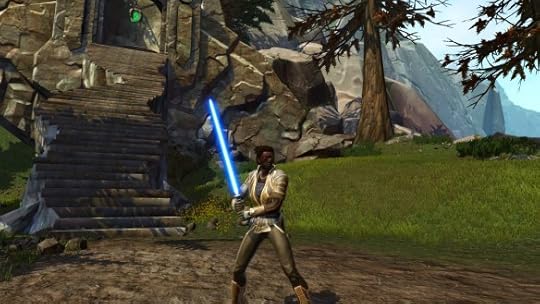 Of course, I’d already experienced the mechanics of both classes while trying their Sith equivalents. I already knew I liked the knight/warrior mechanics. Yet something interesting happened with consular. A class that I disliked as a Sith was actually fairly fun as a Jedi.
Of course, I’d already experienced the mechanics of both classes while trying their Sith equivalents. I already knew I liked the knight/warrior mechanics. Yet something interesting happened with consular. A class that I disliked as a Sith was actually fairly fun as a Jedi.
Of course, they’re mechanically identical. Only aesthetically different. Yet somehow that’s enough.
I think a lot of it comes down to expectation. When I think Sith, I think unbridled fury. I want to wade into the fray and impose my will upon enemies. So when the inquisitor was more about force powers than lightsaber techniques, I was disappointed.
Yet Jedi are far more calm and spiritual. For them, it makes sense to focus more on mental disciplines.
Consular’s spells are also more based on telekinesis. Again, mechanically identical, but I find hurling giant rocks at people more interesting than the lightning powers of the Sith, which end up feeling like what you’d see from any mage class in any other MMO.
So not only do the consular’s force powers not bother me as they did with the inquisitor, I even ended up choosing the sub-class more focused on spellcasting.
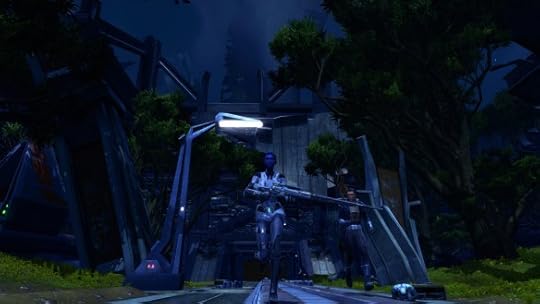 I have been noticing for a while that — at least for me — role-play and head canon can make a big difference in how I play and what I enjoy in games.
I have been noticing for a while that — at least for me — role-play and head canon can make a big difference in how I play and what I enjoy in games.
For example, as a rule, I’m not fond of farming for resources or putting much effort into crafting. Yet I’ve been spending a lot of time doing just that in Elder Scrolls Online. Part of this is due to ESO making that a more rewarding activity in general, but a lot of it is down to the simple fact I play a Bosmer. It makes sense for a tribal hunter-gatherer to be living off the land and gathering and crafting her own supplies.
I noticed something similar in Dragon Age: Inquisition. Playing as a Dalish Keeper, I didn’t mind so much harvesting supplies from the wilderness. Again, it’s just what they do. Whereas on my Qunari, I really did view it as nothing but a chore.
I’m sure I could think of lots of other examples of RP altering my play preferences. I know it influences my zone choices in WoW. I wonder if anyone else finds this to be the case? It’s probably just me being weird again.
So, anyway, right now, it’s looking like my Republic main is going to be a Jedi sage. Right now I’m playing him mainly light side, though I don’t plan to be too rigid about it. I will definitely deviate from the Jedi Code from time to time, because there are some aspects of the Jedi philosophy that are just so powerfully stupid and wrong-headed I could never force myself to follow them.
 My general thinking is he is a proper spiritually enlightened type. Taking a bit of inspiration from the Diablo crusader. He’s calm, wise, and compassionate, but still down to earth and approachable, with a good sense of humour — I like taking snarky conversation options where possible.
My general thinking is he is a proper spiritually enlightened type. Taking a bit of inspiration from the Diablo crusader. He’s calm, wise, and compassionate, but still down to earth and approachable, with a good sense of humour — I like taking snarky conversation options where possible.
Meanwhile, I also decided to go back to the inquisitor long enough to finish Korriban — mainly for the payout of Cartel Coins, paltry though it may be — and now I’m wondering if maybe I do want to play it after all, despite my previously deciding to focus on the warrior.
I still wish for more lightsaber-focused abilities, but maybe what I have is enough. And I really like both the story and the voice acting for the inquisitor. Warrior story and voice acting are decent so far, but inquisitor really grabs me.
But I really do like Vette…
As an aside, I realize this is somewhat subjective, but it seems to me like the first companion for almost every class, well, sucks. I’ve played six classes far enough to get a companion, and of them all, Vette is the only initial companion I like. Qyzen and Khem are bland one-note characters, Kaliyo is an unrepentant psychopath, Aric is just a prick, and the first Jedi knight companion is an appliance.
Companions are also my only major reservation about choosing consular over knight, because I know knight gets Jaina Proudmoore as a companion later on.
 (Yeah, I know her name is Laura Bailey, but she’ll always be Jaina to me.)
(Yeah, I know her name is Laura Bailey, but she’ll always be Jaina to me.)
Agh, I’m so confused. I want to play everything!
A new writing gig:
In other news, I have just started on a new game writing gig. From here on in, I’ll be contributing regular content to the newly launched site MMOBro. My first contribution is Six MMOs to Watch in 2016. From fresh titles to older games with exciting new developments.
Filed under: Games, My writing Tagged: sci-fi, Star Wars, Star Wars: The Old Republic, writing











